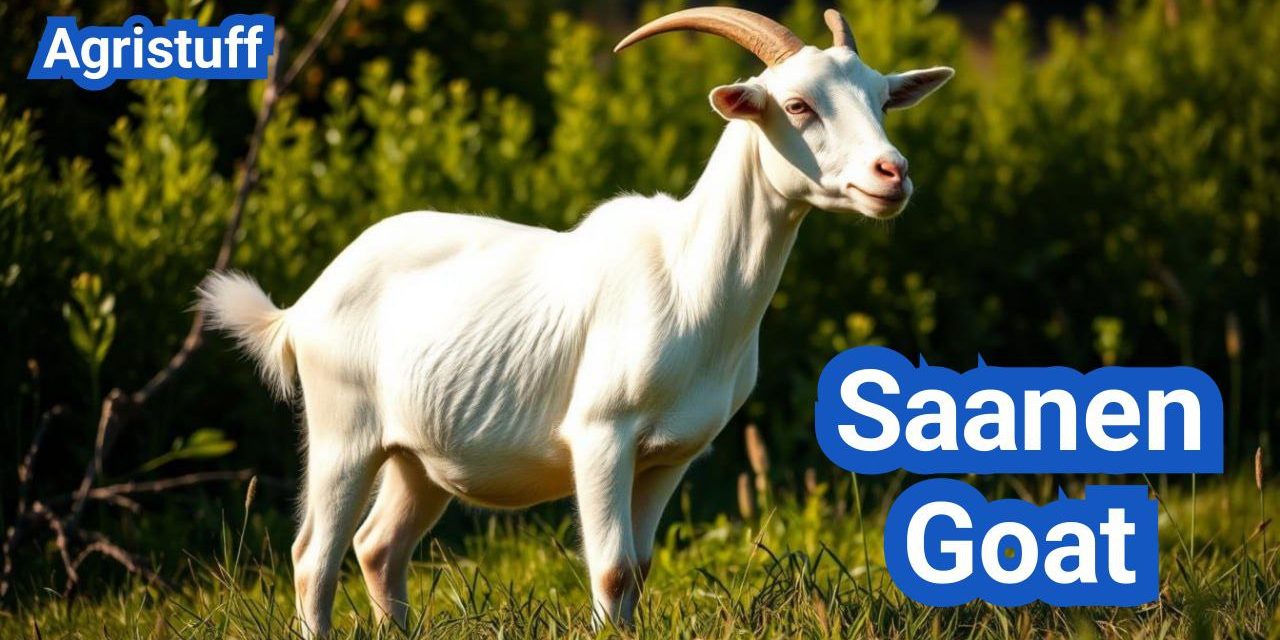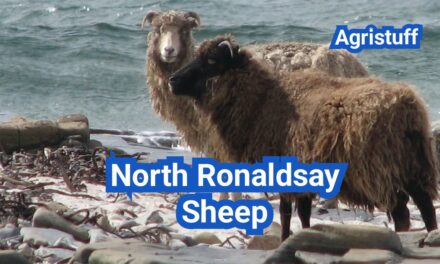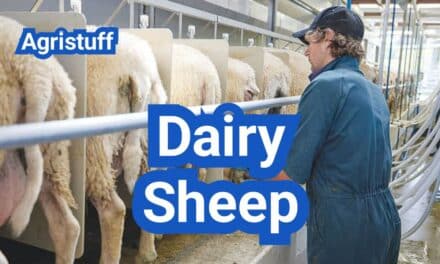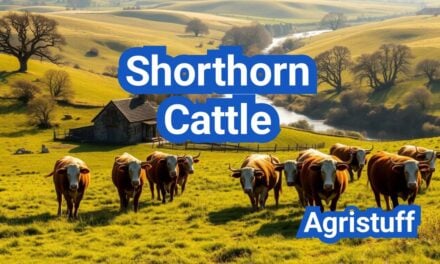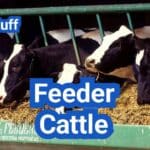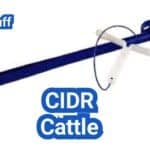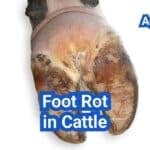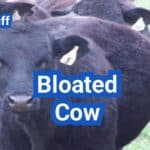The Saanen breed ( Saanen Goat ) is a renowned Swiss dairy goat known for its exceptional milk production. Originating from the Saanen Valley in western Switzerland, this breed has gained popularity worldwide for its high-quality dairy products.
The breed is characterized by its white coat and is highly productive, making it a favorite among dairy farmers. With its impressive dairy qualities, the Saanen is often used in dairy farming to enhance milk production.
This article will explore the characteristics, origin, and management of this dairy goat breed, providing insights for dairy farmers and enthusiasts.
Key Takeaways
- Origin of the Saanen dairy goat breed
- Characteristics of the Saanen breed
- Dairy production capabilities
- Global distribution and popularity
- Management practices for Saanen goats
The Origin and History of Saanen Goats
Originating from the picturesque Saanen Valley in Switzerland, the Saanen goat has a storied past. The breed’s history is deeply rooted in its dairy production capabilities, making it a sought-after breed globally.
Swiss Beginnings in Saanen Valley
The Saanen goat breed originated in the Saanen Valley and the neighboring Simmental region in the Bernese Oberland, Switzerland. The breed was developed for its exceptional dairy qualities, which remain a hallmark of the breed to this day. The Saanen goat’s dairy production capabilities were highly valued, leading to its widespread adoption.
The historical context of the Saanen goat’s development is crucial in understanding its characteristics. The breed was bred to thrive in the mountainous regions of Switzerland, adapting to the local climate and terrain. This adaptability has contributed to the breed’s success in various parts of the world.
Global Spread and Development
Over time, the Saanen goat has been exported to numerous countries, leading to the development of various sub-breeds. This global spread has not only diversified the breed but also enhanced its dairy production capabilities through selective breeding practices.
The global development of the Saanen goat breed can be attributed to several factors, including:
- Its high milk production potential
- Adaptability to different climates and farming systems
- The demand for high-quality dairy products
Today, the Saanen goat is recognized as one of the premier dairy goat breeds worldwide, with a significant presence in many countries. Its history and global spread are a testament to the breed’s versatility and value in dairy production.
Understanding Saanen Goat Characteristics

Saanen goats are distinguished by their impressive size, temperament, and milk-producing capabilities. These characteristics make them a popular choice among dairy farmers worldwide.
Physical Appearance and Size
The Saanen goat is the largest breed of Swiss goat, with males standing about 90 cm at the withers and weighing a minimum of 85 kg. They have a distinctive white coat, which is one of their defining features. Saanen goats can be either horned or hornless, offering flexibility in their physical appearance based on breeding choices.
Their size is a significant factor in their popularity, as it often correlates with higher milk production. The breed’s overall physical stature and robust health contribute to its suitability for dairy farming.
Temperament and Behavioral Traits
Saanen goats are known for their calm and gentle temperament, making them easier to handle, especially in a dairy farming context. They are generally docile and can be quite friendly, which is advantageous for farmers who need to manage them regularly.
Their behavioral traits also include a strong instinct to follow a leader, which can simplify the management of a herd. Understanding and leveraging these traits can help in creating a more efficient and stress-free farming environment.
Lifespan and Developmental Stages
The average lifespan of a Saanen goat is between 12 to 15 years, depending on various factors such as health, nutrition, and management practices. They go through several developmental stages, from kid to adult, with the first kidding typically occurring between 12 to 18 months of age.
Proper care and nutrition during these developmental stages are crucial for ensuring that Saanen goats reach their full potential in terms of milk production and overall health.
Why Choose Saanen Goats for Dairy Production
The Saanen breed stands out in the dairy goat world for its impressive milk yield and superior milk quality. Originating from the Saanen Valley in Switzerland, these goats have been bred for their exceptional dairy production capabilities.
Impressive Milk Yield Statistics
Saanen goats are renowned for their high milk production. On average, a Saanen goat produces around 838 kg of milk in a lactation period of 264 days. This impressive milk yield makes them an attractive choice for dairy farmers looking to maximize their production.
Milk yield is a critical factor in dairy farming, and Saanen goats consistently deliver high volumes. Their ability to produce milk efficiently is a result of careful breeding and selection over the years.
Milk Quality and Composition Benefits
The milk produced by Saanen goats is not only abundant but also of high quality. It contains a minimum of 3.2% fat and 2.7% protein, making it ideal for producing a variety of dairy products such as cheese, butter, and yogurt.
The rich composition of Saanen goat milk is beneficial for both dairy farmers and consumers. The high fat and protein content enhance the flavor and nutritional value of dairy products.
Comparison with Other Dairy Goat Breeds
When compared to other dairy goat breeds, Saanen goats stand out for their milk production capabilities. While breeds like Alpine and Toggenburg also offer good milk yield, Saanen goats are often preferred for their consistent production and milk quality.
A comparison of dairy goat breeds highlights the advantages of Saanen goats. Their milk yield and quality make them a top choice among dairy farmers. Here is a brief overview:
| Breed | Average Milk Yield (kg) | Lactation Period (days) | Milk Fat (%) | Milk Protein (%) |
|---|---|---|---|---|
| Saanen | 838 | 264 | 3.2 | 2.7 |
| Alpine | 810 | 260 | 3.1 | 2.6 |
| Toggenburg | 770 | 255 | 3.0 | 2.5 |
In conclusion, Saanen goats offer a compelling combination of high milk yield and superior milk quality, making them an excellent choice for dairy production.
How to Set Up Your Farm for Saanen Goats

Setting up a farm for Saanen goats requires careful planning and preparation to ensure the health and productivity of these valuable dairy animals. A well-designed farm setup is crucial for maximizing milk production and maintaining the overall well-being of the goats.
Designing Proper Housing and Shelter
Proper housing is essential for protecting Saanen goats from harsh weather conditions and providing them with a comfortable living environment. The housing should be well-ventilated, dry, and draft-free. Consider the following factors when designing housing for your Saanen goats:
- Provide adequate space: Ensure that each goat has enough room to stand, turn around, and lie down comfortably.
- Use suitable materials: Construct housing using durable materials that can withstand various weather conditions.
- Maintain cleanliness: Regularly clean and disinfect the housing area to prevent disease.
Fencing and Outdoor Areas
Effective fencing is critical for keeping Saanen goats contained and secure. The fencing should be sturdy and tall enough to prevent escape. When designing outdoor areas, consider the following:
- Use appropriate fencing materials: Choose materials that are durable and suitable for goat farming, such as high-tensile wire or electric fencing.
- Create adequate grazing areas: Ensure that the outdoor areas provide sufficient grazing space for your Saanen goats.
- Incorporate shelter: Provide shade and shelter in outdoor areas to protect goats from extreme weather.
Essential Equipment Checklist
To manage your Saanen goat farm efficiently, you’ll need the right equipment. Here’s a checklist of essential items:
- Milking equipment: Invest in a reliable milking machine or hand milking equipment, depending on the size of your operation.
- Feeding and watering systems: Ensure that your goats have access to clean water and nutritious feed at all times.
- Health management tools: Keep a well-stocked first-aid kit and have necessary medications on hand.
By carefully planning and implementing these elements, you can create a thriving Saanen goat farm that produces high-quality milk and maintains the health and happiness of your goats.
Step-by-Step Guide to Raising Saanen Goats
The key to raising healthy Saanen goats lies in proper care and management. This involves several crucial steps that ensure the well-being and productivity of your goats.
Selecting and Purchasing Quality Stock
Selecting the right Saanen goats is the foundation of a successful dairy farming operation. When purchasing stock, look for goats that are healthy, well-conformed, and have a good temperament. It’s essential to buy from reputable breeders who can provide health records and breeding information.
Key factors to consider when selecting Saanen goats include:
- Age and health status
- Genetic lineage and breeding history
- Physical condition and conformation
- Temperament and behavior
Establishing a Daily Care Routine
A daily care routine is vital for maintaining the health and productivity of your Saanen goats. This routine should include feeding, milking, health checks, and providing clean living conditions.
| Task | Frequency | Notes |
|---|---|---|
| Feeding | Twice daily | Provide high-quality hay, grains, and minerals |
| Milking | Twice daily | Maintain hygiene and follow milking protocols |
| Health checks | Daily | Monitor for signs of illness or injury |
| Cleaning living areas | Daily | Remove soiled bedding and waste |
Seasonal Management Calendar
Managing your Saanen goats according to a seasonal calendar helps in addressing their changing needs throughout the year. This includes adjusting their diet, health care, and living conditions according to the season.
For example:
- Spring: Increase nutritional intake to support lactation and kid rearing.
- Summer: Ensure adequate cooling and hydration to combat heat stress.
- Autumn: Prepare goats for the coming winter by adjusting their diet and ensuring they are in good health.
- Winter: Provide extra nutrition and ensure warm, dry living conditions.
By following these steps and maintaining a comprehensive care routine, you can ensure the health and productivity of your Saanen goats. Proper management is key to a successful dairy farming operation.
Complete Saanen Goat Feeding Guide

Understanding the nutritional requirements of Saanen goats is the first step in creating an effective feeding plan. A well-balanced diet is crucial for their overall health and productivity.
Understanding Nutritional Requirements
Saanen goats, like other dairy breeds, have specific nutritional needs that must be met to ensure optimal health and milk production. Their diet should include a mix of energy sources, proteins, vitamins, and minerals.
Nutritional Components:
- Energy sources: Carbohydrates and fats
- Proteins: Essential for growth and milk production
- Vitamins: Vital for overall health
- Minerals: Crucial for bone health and other bodily functions
Creating a Balanced Diet Plan
To create a balanced diet plan for Saanen goats, farmers should consider the quality and quantity of feed. High-quality hay, silage, and concentrates are essential components.
Key Considerations:
- Quality of feed: Ensure that the feed is free from mold and contaminants.
- Quantity of feed: Adjust according to the goat’s life stage and production level.
- Access to clean water: Essential for digestion and overall health.
Adjusting Feed for Different Life Stages
Saanen goats have different nutritional requirements at various life stages. For instance, kids require more protein for growth, while lactating does need additional energy and nutrients to support milk production.
| Life Stage | Nutritional Needs | Feed Adjustments |
|---|---|---|
| Kids | High protein for growth | Increase protein-rich feed |
| Lactating Does | Additional energy and nutrients | Increase energy and nutrient-rich feed |
| Dry Does | Maintenance level nutrients | Adjust to maintenance level feed |
By understanding and meeting these nutritional needs, farmers can ensure the health and productivity of their Saanen goats.
Mastering Saanen Goat Health Management
Saanen goat health management is a multifaceted approach that involves preventative measures, early detection of illnesses, and timely veterinary interventions. Effective health management is critical for maintaining the productivity and well-being of these dairy goats.
Preventative Health Protocols
Preventative health protocols form the backbone of Saanen goat health management. These include:
- Regular vaccinations to protect against common diseases
- Parasite control measures, such as deworming and monitoring for internal parasites
- Hoof care, including regular trimming to prevent hoof rot and lameness
- Nutritional management to ensure a balanced diet that supports overall health
As noted by agricultural experts, “A proactive approach to health care can significantly reduce the incidence of disease in goat herds.”
“Prevention is always better than cure, especially when it comes to the health of your Saanen goats.”
| Health Protocol | Frequency | Benefits |
|---|---|---|
| Vaccinations | Annually | Protection against diseases such as CDT and Bo-Se |
| Deworming | Quarterly | Reduces parasite load, improving overall health |
| Hoof Trimming | Every 6-8 weeks | Prevents lameness and hoof rot |
Recognizing and Treating Common Ailments
Saanen goats are susceptible to various health issues, including mastitis, parasites, and respiratory infections. Early detection is key to effective treatment.
Common signs of illness include changes in appetite, lethargy, and abnormal feces or urine. Farmers should be vigilant and monitor their goats regularly.
When to Call the Veterinarian
Knowing when to seek veterinary care is crucial. Situations that warrant immediate attention include severe symptoms, injuries, or signs of infectious diseases.
A veterinarian can provide guidance on health management, diagnose illnesses, and administer appropriate treatments. Regular consultations can help prevent health issues and improve the overall health of the herd.
How to Breed Saanen Goats Successfully

To breed Saanen goats effectively, farmers must focus on key areas such as breeding stock selection, breeding management, and kidding preparation. Successful breeding of Saanen goats requires a comprehensive understanding of the breed’s characteristics and the principles of dairy goat breeding.
Selecting Breeding Stock for Improvement
Selecting the right breeding stock is crucial for improving the dairy traits of Saanen goats. Farmers should look for animals with high milk production records, good udder quality, and a strong conformation that aligns with the breed standards. Genetic testing can also be beneficial in identifying superior genetic lines.
The selection process involves evaluating the physical characteristics and production history of potential breeding animals. This includes assessing their milk yield, fat content, and overall health. By choosing breeding stock with desirable traits, farmers can enhance the productivity of their Saanen goat herd.
Managing the Breeding Process
Managing the breeding process involves several critical steps, including planning the breeding season, ensuring the health of the breeding stock, and monitoring the breeding process. Proper nutrition is essential for the reproductive health of both does and bucks.
Farmers should maintain detailed records of breeding dates, sire information, and expected kidding dates. This helps in planning for kidding and ensuring that the necessary care is provided to the newborn kids.
Kidding Preparation and Assistance
Preparing for kidding involves creating a clean and safe environment for the does to give birth. Farmers should be prepared to assist with kidding if necessary, recognizing signs of labor and knowing when to intervene.
A well-planned kidding preparation includes having a kidding kit ready with essential supplies such as clean towels, iodine for navel dipping, and a heat source for the newborn kids. Understanding the signs of normal and difficult births is crucial for ensuring the health and safety of both the doe and the kids.
Step-by-Step Milking Techniques for Saanen Goats

Effective milking techniques are essential for Saanen goat dairy farming success. Milking Saanen goats efficiently requires a well-set-up milking area and proper milking techniques, whether hand milking or using milking machines.
Setting Up an Efficient Milking Area
Creating an efficient milking area is the first step towards successful milking. The milking area should be clean, well-ventilated, and designed to minimize stress on both the goats and the milker. Proper milking area setup involves ensuring that all necessary equipment is within easy reach and that the goats are comfortable and secure during the milking process.
As Hoard’s Dairyman suggests, “A well-designed milking parlor can significantly improve milking efficiency and reduce labor costs.” This underlines the importance of investing time and resources into setting up an optimal milking environment.
Hand Milking Process
Hand milking is a traditional method that requires skill and practice to master. To hand milk effectively, start by ensuring the udder is clean and dry. Gentle stimulation of the udder helps initiate milk letdown. The milking process should be smooth and rhythmic, with attention paid to stripping the teat to remove any remaining milk.
“The art of hand milking lies in its gentle yet firm technique, ensuring the comfort of the goat while maximizing milk yield.”
Machine Milking Guidelines
For larger dairy operations, machine milking is often the preferred method due to its efficiency and ability to handle multiple goats simultaneously. When using milking machines, it’s crucial to follow the manufacturer’s guidelines for operation and maintenance. Regular checks on the equipment ensure that it functions correctly and that the milking process is not stressful for the goats.
A key aspect of machine milking is proper teat dipping and udder care post-milking to prevent mastitis and maintain overall udder health.
- Ensure the milking machine is properly fitted to the goat.
- Monitor milking time to avoid over-milking.
- Regularly clean and maintain the milking equipment.
By following these step-by-step milking techniques, dairy farmers can improve their milking efficiency, maintain the health of their Saanen goats, and produce high-quality milk.
Exploring Saanen Goat Varieties

Beyond the standard Saanen, breeders have developed other notable varieties such as Sable Saanens and Mini Saanens, offering a range of choices for dairy farmers. These varieties cater to different needs and preferences, whether it’s for milk production, size, or color.
Standard Saanen Characteristics
The standard Saanen goat is renowned for its high milk production and robust health. They are typically white or cream-colored, with a sturdy build and a calm demeanor. Standard Saanens are a popular choice among dairy farmers due to their impressive milk yield and ease of handling.
Sable Saanens and Color Variants
Sable Saanens are a color variant of the standard Saanen, characterized by their brown or black coat. They share the same high milk production capabilities as the standard Saanen but offer a different aesthetic. Sable Saanens are gaining popularity for their unique appearance and similar dairy production qualities.
Mini Saanen Development and Uses
Mini Saanens are a smaller version of the standard Saanen, bred to retain the desirable dairy traits in a more compact size. They are ideal for smaller farms or homesteads where space is limited. Mini Saanens are not only used for dairy production but also make great pets due to their friendly nature.
Saanen-Alpine Crosses
Crossing Saanen goats with Alpine goats results in a robust dairy goat that combines the best traits of both breeds. Saanen-Alpine crosses are known for their high milk production and hardiness, making them an excellent choice for commercial dairy farming. These crosses benefit from hybrid vigor, often resulting in improved health and productivity.
How to Market Saanen Goat Products Profitably

To profitably market Saanen goat products, farmers must adopt effective pricing and sales strategies. The profitability of dairy farming operations significantly depends on how well the products are marketed to potential customers.
Pricing and Selling Saanen Milk
Pricing Saanen milk correctly is crucial for attracting and retaining customers. The price should reflect the quality and nutritional benefits of the milk. Competitive pricing strategies can help in penetrating the market effectively.
A detailed analysis of production costs, market demand, and competitor pricing is essential for setting the right price. Here’s a simple table to illustrate the factors to consider:
| Factor | Description | Impact on Pricing |
|---|---|---|
| Production Costs | Includes feed, labor, and maintenance costs | Directly affects the minimum price |
| Market Demand | High demand can support higher prices | Influences the maximum price |
| Competitor Pricing | Prices of similar products in the market | Determines competitive pricing |
Value-Added Product Opportunities
Creating value-added products from Saanen goat milk can significantly enhance profitability. Products like cheese, butter, and yogurt have a higher market value than raw milk. Innovative packaging and branding can further differentiate these products in a competitive market.
Building a Customer Base
Building a loyal customer base is vital for the long-term success of Saanen goat dairy farming. Engaging with customers through farmers’ markets, social media, and educational content can help build trust and loyalty. Customer feedback should be actively sought and incorporated into product development and marketing strategies.
By focusing on these areas, Saanen goat farmers can develop a profitable marketing strategy that attracts and retains customers, ultimately enhancing the sustainability of their dairy farming operations.
Implementing Sustainable Practices with Saanen Goats

To ensure environmental conservation and farm viability, sustainable practices are essential in Saanen Goat dairy farming. Sustainable goat milk production not only enhances the quality of the milk but also contributes to the overall health of the farm ecosystem.
Pasture Management and Rotation
Effective pasture management is critical for maintaining soil health, reducing erosion, and promoting biodiversity. Rotating pastures helps in distributing the grazing pressure evenly, allowing pastures to recover and regenerate. This practice is vital for maintaining the nutritional quality of the feed for Saanen Goats.
Implementing a rotational grazing system can be achieved by dividing pastures into smaller sections and moving the goats regularly. This method not only improves pasture productivity but also enhances the overall environmental sustainability of the farm.
Waste Management Solutions
Managing waste effectively is another crucial aspect of sustainable Saanen Goat dairy farming. Proper waste management involves strategies for handling manure and other farm waste, reducing the environmental impact of the farm.
- Implementing manure composting to reduce waste volume and create valuable fertilizer.
- Using proper storage facilities for manure to prevent runoff and contamination.
- Adopting waste recycling practices to minimize the farm’s ecological footprint.
Reducing Environmental Impact
Reducing the environmental impact of Saanen Goat dairy farming involves adopting practices that minimize the farm’s carbon footprint and promote ecological balance. This can be achieved through energy-efficient practices, water conservation, and protecting natural habitats.
By integrating these sustainable practices, Saanen Goat dairy farms can not only improve their productivity but also contribute to environmental conservation. This holistic approach ensures the long-term viability of the farm and the quality of its products.
Troubleshooting Common Saanen Goat Challenges

Troubleshooting is an essential skill for Saanen goat farmers to master in order to maintain a healthy and productive herd. Common challenges in raising Saanen goats include behavioral problems, production issues, and seasonal difficulties.
Resolving Behavioral Problems
Behavioral issues in Saanen goats can range from aggression to anxiety. Identifying the root cause of these behaviors is crucial. Factors such as environment, diet, and social structure can influence behavior.
To address behavioral problems, farmers should first ensure that their goats have a comfortable and safe living environment. This includes adequate space, appropriate shelter, and a balanced diet.
- Monitor the herd regularly for signs of stress or anxiety.
- Provide enrichment activities to reduce boredom and stress.
- Ensure proper socialization among the goats.
Addressing Production Issues
Production issues, such as low milk yield or poor quality milk, can significantly impact a dairy farm’s profitability. Regular monitoring of milk production and quality is essential.
To address production issues, farmers should focus on providing a high-quality diet that meets the nutritional needs of their Saanen goats. This includes a balanced mix of forage, concentrates, and minerals.
| Nutritional Element | Importance |
|---|---|
| Forage | Provides fiber, essential for digestive health. |
| Concentrates | Supplies energy and protein for milk production. |
| Minerals | Crucial for overall health and milk quality. |
Managing Seasonal Difficulties
Seasonal changes can bring about various challenges for Saanen goat farmers, including extreme temperatures, parasites, and nutritional deficiencies.
To manage seasonal difficulties, farmers should be prepared to adjust their management practices accordingly. This includes providing appropriate shelter and ventilation during hot weather and ensuring adequate nutrition during periods of scarcity.
Key strategies include:
- Adjusting feeding practices to meet seasonal nutritional needs.
- Implementing parasite control measures during peak parasite seasons.
- Ensuring adequate shelter and ventilation to protect against extreme weather conditions.
Beginner’s Guide to Saanen Goat Success
Embarking on a Saanen goat farming journey requires careful planning and a thorough understanding of what to expect in the first 30 days. New farmers can significantly benefit from a structured approach to setting up their farm and managing their Saanen goats effectively.
First 30 Days Checklist
The initial 30 days are crucial for setting the foundation of a successful Saanen goat farming operation. Here is a checklist to help guide new farmers:
- Ensure proper housing and fencing for the goats.
- Establish a feeding routine that meets the nutritional needs of Saanen goats.
- Implement a health management plan, including vaccinations and parasite control.
- Set up a milking routine and ensure the milking area is clean and efficient.
- Monitor the goats’ behavior and overall health daily.
Finding Mentors and Support Networks
Finding experienced mentors and joining support networks can be invaluable for new Saanen goat farmers. These resources can provide guidance, share best practices, and offer support during challenging times.
Mentor Benefits:
| Benefit | Description |
|---|---|
| Expert Guidance | Mentors can offer expert advice based on their experience. |
| Problem-Solving | Mentors can help troubleshoot common issues and challenges. |
| Networking Opportunities | Mentors can introduce new farmers to valuable contacts within the industry. |
Recommended Resources and Learning Tools
Utilizing recommended resources and learning tools can enhance a new farmer’s knowledge and skills. Some valuable resources include:
- Online courses and webinars focused on Saanen goat farming.
- Agricultural extension services provided by local universities or colleges.
- Books and publications on goat farming and dairy production.
- Industry conferences and workshops.
By following this beginner’s guide, new Saanen goat farmers can establish a strong foundation for their farming operation, ensuring a successful and sustainable venture.
The Enduring Value of Saanen Goats
Saanen goats have established themselves as a cornerstone in dairy goat farming due to their exceptional milk production and adaptability. The value they bring to dairy farming operations is multifaceted, encompassing not only their high milk yield but also the quality of their milk, making them a preferred choice among dairy farmers worldwide.
The benefits of raising Saanen goats are evident in their robust health, ease of management, and the versatility of their milk for various dairy products. As the dairy farming industry continues to evolve, the Saanen goat remains an integral part of it, offering a reliable source of high-quality milk.
For those involved in dairy goat farming, the Saanen goat’s enduring value lies in its potential to enhance farm productivity and profitability. By understanding and leveraging the unique characteristics and benefits of Saanen goats, farmers can optimize their dairy operations and achieve greater success in the competitive dairy market.
FAQ
What is the origin of the Saanen Goat breed?
The Saanen Goat breed originates from the Saanen Valley in Switzerland, where it was bred for its exceptional dairy qualities.
What are the characteristics of Saanen Goats?
Saanen Goats are known for their white coat, size, and temperament. They are the largest Swiss goat breed and are recognized for their high milk production.
How much milk do Saanen Goats produce?
Saanen Goats are highly productive, with impressive milk yield statistics. They are preferred for dairy production due to their high milk yield and quality.
What is the lifespan of a Saanen Goat?
Understanding the lifespan and developmental stages of Saanen Goats is essential for effective management and care. The average lifespan is around 10-15 years.
How do I feed Saanen Goats?
Feeding Saanen Goats requires understanding their nutritional needs and creating a balanced diet plan. The nutritional requirements vary across different life stages.
What are the common health issues in Saanen Goats?
Mastering the health management of Saanen Goats involves implementing preventative health protocols and recognizing and treating common ailments.
How do I breed Saanen Goats successfully?
Successful breeding of Saanen Goats requires careful selection of breeding stock, managing the breeding process, and preparing for kidding.
What are the different varieties of Saanen Goats?
The Saanen breed has several varieties, including the standard Saanen, Sable Saanens, and Mini Saanens. Crossing Saanen with other breeds like Alpine goats creates robust dairy goats.
How do I market Saanen Goat products profitably?
To market Saanen Goat products profitably, one must correctly price and sell Saanen milk, explore opportunities for value-added products, and build a strong customer base.
What are the sustainable practices for Saanen Goat farming?
Sustainable dairy farming with Saanen Goats involves practices like pasture management and rotation, effective waste management, and reducing the overall environmental impact.
What are the common challenges in Saanen Goat farming?
Troubleshooting common challenges involves identifying and resolving behavioral problems, addressing production issues, and managing seasonal difficulties.
What are the benefits of raising Saanen Goats for dairy production?
Saanen Goats provide significant and enduring value to dairy farming due to their high milk production, adaptability, and the quality of their milk.
Saanen Goat: Overview
The Saanen goat, often hailed as the best dairy goat breed in the world, originates from the picturesque Saanen Valley in Switzerland. Renowned for its high milk production, calm temperament, and adaptability, this breed has become a favorite among dairy farmers in the USA and globally. Whether you’re a beginner looking to start a dairy goat farm or an experienced farmer aiming to maximize goat milk production, the Saanen dairy goat breed is an excellent choice.
In this comprehensive guide, we’ll explore everything you need to know about raising Saanen goats, from their milk yield and feeding requirements to health management and sustainable farming practices.
Why Choose the Saanen Goat for Dairy Farming?
The Saanen goat is often compared to the Holstein Friesian cattle due to its exceptional milk production, making it the top dairy goat breed worldwide. Here’s why farmers in the USA and beyond prefer Saanens:
- High Milk Yield: A single Saanen doe can produce 3-4 liters of milk per day, with some elite does reaching up to 5 liters during peak lactation.
- Consistent Lactation: They maintain steady production for 180-300 days per lactation cycle, ensuring a reliable dairy supply.
- Low Butterfat Content (3-4%): Ideal for fluid milk, cheese, and yogurt production.
- Docile Temperament: Easy to handle, making them perfect for beginners in dairy goat farming.
For more details on dairy goat breeds, check the American Dairy Goat Association.
Saanen Goat Characteristics and History
Origin and Global Popularity
The Saanen goat breed was developed in Switzerland’s Saanen Valley and has since been exported to over 80 countries, including the USA, where it was first introduced in 1904. Due to its high milk yield, it has been crossbred with local goats worldwide, leading to variants like the French Saanen and Russian White.
Physical Traits
- Color: Pure white or light cream (black spots on ears/nose are rare).
- Size: Large breed—females weigh 60-70 kg, males 85-90 kg.
- Ears: Upright and forward-facing.
- Adaptability: Thrives in temperate climates but needs shade to prevent sunburn due to their light skin.
Learn more about Saanen breed standards from the National Saanen Breeders Association.
Saanen Goat Milk Production in the USA
The USA’s dairy goat industry has grown significantly, with Saanen goats playing a key role in commercial and small-scale farms. Here’s what makes them ideal for goat milk production in the USA:
- Average Yield: 1,168 liters per lactation (higher than Alpine and Nubian goats).
- Milk Composition: 3.3% fat, 2.9% protein—perfect for cheese and yogurt.
- Market Demand: Increasing due to lactose-intolerant consumers preferring goat milk.
For dairy farming insights, visit the USDA National Agricultural Statistics Service.
Raising Saanen Goats – A Beginner’s Guide
Housing and Shelter
- Space Requirement: 150-200 sq ft per goat (indoor + outdoor grazing).
- Shelter Needs: Well-ventilated barns with straw bedding to prevent respiratory issues.
- Fencing: 4-5 ft high, escape-proof fencing (they’re notorious for breaking out!).
Feeding Saanen Goats for Optimal Milk Yield
- Primary Diet: High-quality hay (alfalfa, clover).
- Supplements: Grain mixes (oats, corn) for lactating does.
- Minerals: Calcium, phosphorus, and selenium blocks.
For a detailed feeding guide, see Dairy Goat Nutrition by Penn State Extension.
Saanen Goat Health Management
Keeping your Saanen goats healthy ensures consistent milk production:
- Vaccinations: Clostridial diseases (tetanus, enterotoxemia).
- Deworming: Regular fecal checks to prevent parasites.
- Hoof Care: Trim every 4-6 weeks to avoid foot rot.
- Sun Protection: Provide shade to prevent sunburn.
For goat health resources, check Merck Veterinary Manual.
Sustainable Goat Milk Production with Saanens
Eco-friendly dairy farming is achievable with Saanen goats:
- Manure Management: Use as organic fertilizer.
- Rotational Grazing: Prevents pasture degradation.
- Low Carbon Footprint: Goats require less feed than cows per liter of milk.
Learn about sustainable practices from Sustainable Agriculture Research & Education (SARE).
Milking Saanen Goats – Best Practices
Maximize milk yield with these tips:
- Milking Routine: Twice daily, 12 hours apart.
- Udder Hygiene: Clean before milking to prevent mastitis.
- Machine vs. Hand Milking: Commercial farms use machines, small farms prefer hand milking.
For milking equipment, visit Hoegger Supply Company.
Final Thought
The Saanen goat is undoubtedly the best dairy goat breed for farmers seeking high milk production, ease of management, and profitability. Whether you’re in the USA or elsewhere, incorporating Saanens into your dairy operation can lead to sustainable and lucrative goat milk production. By following proper feeding, health, and milking practices, you can ensure your Saanen goats thrive and deliver exceptional yields.
Ready to start your Saanen goat farm? Explore breeding options from reputable sources like Lake Country Goats and join the thriving dairy goat farming community!
Conclusion of: Saanen Goat
Saanen goat is one of the most valued dairy goat breeds in the world, known for its outstanding milk production, calm disposition, and adaptability to various climates. Originally from Switzerland, Saanen goats have become increasingly popular among dairy farmers in the United States. This comprehensive guide will help you understand everything about Saanen goats, from breed characteristics to feeding, breeding, and care tips.
What Is a Saanen Goat?
A Saanen goat is a dairy goat breed originating from the Saanen Valley in Switzerland. These goats are especially prized for their ability to produce large quantities of high-quality milk with a mild flavor and low butterfat content, making them ideal for commercial dairy operations.
Why Saanen Goats Are Popular in the USA
Saanen goats are popular for several reasons:
- Exceptional milk volume
- Mild-tasting milk preferred by many consumers
- Docile and friendly temperament
- Adaptability to temperate climates across the United States
Physical Characteristics of Saanen Goats
Saanen goats have several defining traits:
- White or cream-colored coats
- Large, upright ears
- Straight or slightly dished faces
- Mature weight: Does (female goats) 130–150 lbs, Bucks (male goats) 170–200 lbs
Milk Production Capacity
One of the primary reasons for raising Saanen goats is their milk yield:
- Average production: 1–3 gallons per day per goat
- Milk composition: Low butterfat (2.5–3.5%), ideal for drinking and soft cheese
- Long lactation periods of up to 10 months
Feeding and Nutrition for Saanen Goats
Proper feeding ensures consistent milk production:
- High-quality pasture or browse
- Alfalfa hay as a key protein source
- Grain supplementation for lactating does
- Free-choice minerals and salt
- Clean water access at all times
Housing and Shelter for Saanen Goats
Saanen goats require clean and dry housing:
- Shelters with good ventilation
- Raised flooring to prevent hoof issues
- Space allocation: At least 15–20 square feet per adult goat
- Protection from extreme heat or cold
Breeding Management in Saanen Goats
Successful breeding ensures herd sustainability:
- Bucks with strong dairy genetics are preferred
- Breeding age for does: 7–10 months
- Kidding (birthing) usually results in twins or triplets
- Controlled breeding schedules to match market demands
Kid Management in Saanen Goat Farming
Healthy kids mean a productive future:
- Ensure colostrum intake within the first 24 hours
- Bottle-feed or dam-raise according to farm setup
- Vaccinate and disbud at the right age
- Monitor growth rates and weaning schedules
Health and Veterinary Care for Saanen Goats
Saanen goats are hardy but require regular health care:
- Vaccinations (CDT, pneumonia prevention)
- Routine deworming
- Hoof trimming every 4–6 weeks
- Monitoring for mastitis and udder health
Milking Techniques for Saanen Goats
Maximizing milk output involves:
- Milking twice daily
- Using sanitized equipment
- Gentle handling to maintain udder health
- Cooling and storing milk immediately after collection
Economic Value of Saanen Goats
Saanen goats offer strong financial benefits:
- High milk yield reduces cost per gallon produced
- Strong demand for goat milk products in the USA
- Long productive lifespan lowers herd replacement costs
- Excellent crossbreeding potential for hybrid dairy goats
Saanen Goats in Sustainable Farming
Saanen goats fit well into eco-friendly farm systems:
- Efficient grazers that control brush and weeds
- Lower feed input compared to dairy cows
- Smaller carbon footprint in milk production
Pros of Raising Saanen Goats
- High milk yield
- Friendly temperament
- Easy to manage for both beginners and experienced farmers
- Versatile for both small-scale and commercial dairy farming
Cons of Raising Saanen Goats
- Less heat-tolerant compared to some other breeds
- Lower butterfat content, which may not suit all cheese types
- Requires consistent milking schedules
- Sensitive to poor housing and hygiene conditions
Finally
Saanen goats represent the gold standard in dairy goat farming for U.S. producers seeking high milk output with manageable care requirements. Their calm demeanor, prolific milk production, and adaptability make them an ideal choice for both beginners and experienced dairy farmers. By focusing on proper nutrition, housing, health care, and breeding management, Saanen goats can be a profitable and sustainable addition to any farm.

